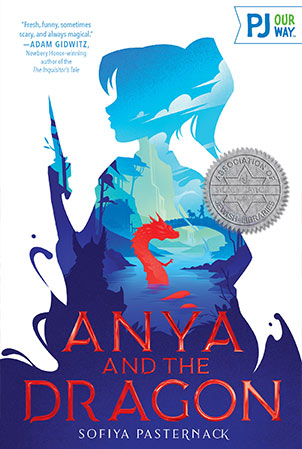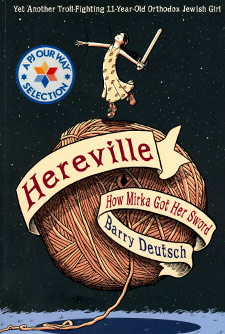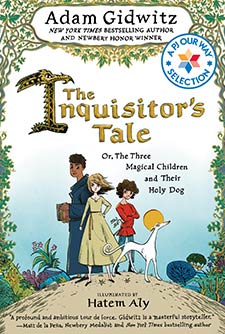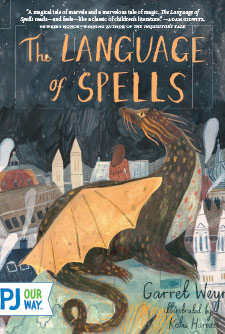Anya and the Dragon
Eleven-year-old Anya has a month to come up with the money to save her family’s home. The tsar’s offering a huge reward to whoever kills a famous dragon. Can Anya find the dragon in time?
Average Rating
( hint: Login to leave a review! )
216 Reviews
Leave Review
What the Book Is About
Jewish Content & Values
Positive Role Models
Content Advisory
Talk It Over
More for You
What the Book Is About
Eleven-year-old Anya and her family are the only Jews in a small village in Eastern Europe sometime in the 7th century. Even though Anya and her family have to hide their magical powers, Anya is hoping to learn the nature of her magic by her bat mitzvah. Her father has been conscripted into the tzar's army, so when the magistrate gives her mother a month to pay a huge sum or lose their home, Anya feels as though she must help.
Not long after, Anya makes friends with the new kid in town, Ivan. When Ivan's father sees that Anya isn't scared of a terrifying fighter who comes to town, he invites her to help find and kill the last known dragon in the region. In return, the promise to give her a part of the reward money. As always, things are more complicated than they seem, and in the end, Anya must decide whether to save her family or her friends.
This is an action-packed, surpisingly funny fantasy that will be perfect for readers who love magic, dragons, and brave heroines!
Not long after, Anya makes friends with the new kid in town, Ivan. When Ivan's father sees that Anya isn't scared of a terrifying fighter who comes to town, he invites her to help find and kill the last known dragon in the region. In return, the promise to give her a part of the reward money. As always, things are more complicated than they seem, and in the end, Anya must decide whether to save her family or her friends.
This is an action-packed, surpisingly funny fantasy that will be perfect for readers who love magic, dragons, and brave heroines!
Jewish Content & Values
- Anya will soon turn 12 and is preparing for her bat mitzvah. Her family has a Torah scroll that her grandmother rescued from a burning synagogue, and Anya reads the Ten Commandments from it in Hebrew. Her father has two copies of the Talmud, which he has read many times.
- Every week Anya bakes challah for the Shabbat meal. The family says the brachah (blessing) over the candles and makes Havdalah at the conclusion of Shabbat. Her grandmother recites the story of Esther on Purim and her mother cooks bliny for Shavuot.
- When the ibbur (benevolent spirit) tells Anya to kill the evil Sigurd, her grandmother tells her that the Ten Commandments say that killing is never justified and that the Talmud says “whoever destroyed a life has destroyed the world.”
Positive Role Models
- When the terrifying Sigurd first comes to town, Anya singlehandedly stands up to him until help comes. When she learns that her family’s home will be confiscated unless they pay a huge sum of money, she demonstrates resourcefulness by deciding to help capture a dragon to win a share of the tsar’s reward. Throughout the book she shows courage and compassion towards others.
- Babulya, Anya’s grandmother, transmits her knowledge of Judaism to the family and ensures that they keep Jewish traditions and festivals including Shabbat and Shavuot. Babulya rescued a Torah scroll from a burning synagogue when she was younger and uses it to help Anya learn to read Hebrew and prepare for her bat mitzvah.
- The villagers wholly accept Anya’s family, who are the only Jewish family in the village. When an antisemitic magistrate threatens to evict them and later tries to turn the villagers against them, they stand up for Anya’s family, run the magistrate out of town, and all celebrate Shavuot together.
Content Advisory
One of Ivan’s brothers draws breasts on an illustration of a fairy in a book about magic. Ivan’s brothers say that he has water magic “like a girl.” They taunt him about thinking another boy is cute and ask where his dress is. The fight scenes contain fantasy violence; a scene where the villain, Sigurd, licks the dragon's blood off a knife may be disturbing to some readers. The word “adultery” is used without explanation in the context of the Ten Commandments.
Talk It Over
Anya’s grandmother tells her that “whoever destroys a single life has destroyed the entire world,” and that killing is unacceptable under any circumstances. But the ibbur asks, “If you commit this sin to save a life, have you destroyed the world, or have you saved it?” and tells her she must kill Sigurd. Who do you think is right, and why?
More for You
Dragons are common characters in children’s fantasy, so it may be surprising that the Tanakh contains references to dragon-like creatures. Isaiah 14:29 says, “Out of the serpent's root shall come forth a viper, and his fruit shall be a fiery serpent.” The sea creature the Leviathan is described as having fire streaming from its mouth, smoke pouring from its nostrils, fearsome teeth, and scales protecting its back (Job 41:18-21).
What the Book Is About
What the Book Is About
Eleven-year-old Anya and her family are the only Jews in a small village in Eastern Europe sometime in the 7th century. Even though Anya and her family have to hide their magical powers, Anya is hoping to learn the nature of her magic by her bat mitzvah. Her father has been conscripted into the tzar's army, so when the magistrate gives her mother a month to pay a huge sum or lose their home, Anya feels as though she must help.
Not long after, Anya makes friends with the new kid in town, Ivan. When Ivan's father sees that Anya isn't scared of a terrifying fighter who comes to town, he invites her to help find and kill the last known dragon in the region. In return, the promise to give her a part of the reward money. As always, things are more complicated than they seem, and in the end, Anya must decide whether to save her family or her friends.
This is an action-packed, surpisingly funny fantasy that will be perfect for readers who love magic, dragons, and brave heroines!
Not long after, Anya makes friends with the new kid in town, Ivan. When Ivan's father sees that Anya isn't scared of a terrifying fighter who comes to town, he invites her to help find and kill the last known dragon in the region. In return, the promise to give her a part of the reward money. As always, things are more complicated than they seem, and in the end, Anya must decide whether to save her family or her friends.
This is an action-packed, surpisingly funny fantasy that will be perfect for readers who love magic, dragons, and brave heroines!
Jewish Content & Values
Jewish Content & Values
- Anya will soon turn 12 and is preparing for her bat mitzvah. Her family has a Torah scroll that her grandmother rescued from a burning synagogue, and Anya reads the Ten Commandments from it in Hebrew. Her father has two copies of the Talmud, which he has read many times.
- Every week Anya bakes challah for the Shabbat meal. The family says the brachah (blessing) over the candles and makes Havdalah at the conclusion of Shabbat. Her grandmother recites the story of Esther on Purim and her mother cooks bliny for Shavuot.
- When the ibbur (benevolent spirit) tells Anya to kill the evil Sigurd, her grandmother tells her that the Ten Commandments say that killing is never justified and that the Talmud says “whoever destroyed a life has destroyed the world.”
Positive Role Models
Positive Role Models
- When the terrifying Sigurd first comes to town, Anya singlehandedly stands up to him until help comes. When she learns that her family’s home will be confiscated unless they pay a huge sum of money, she demonstrates resourcefulness by deciding to help capture a dragon to win a share of the tsar’s reward. Throughout the book she shows courage and compassion towards others.
- Babulya, Anya’s grandmother, transmits her knowledge of Judaism to the family and ensures that they keep Jewish traditions and festivals including Shabbat and Shavuot. Babulya rescued a Torah scroll from a burning synagogue when she was younger and uses it to help Anya learn to read Hebrew and prepare for her bat mitzvah.
- The villagers wholly accept Anya’s family, who are the only Jewish family in the village. When an antisemitic magistrate threatens to evict them and later tries to turn the villagers against them, they stand up for Anya’s family, run the magistrate out of town, and all celebrate Shavuot together.
Content Advisory
Content Advisory
One of Ivan’s brothers draws breasts on an illustration of a fairy in a book about magic. Ivan’s brothers say that he has water magic “like a girl.” They taunt him about thinking another boy is cute and ask where his dress is. The fight scenes contain fantasy violence; a scene where the villain, Sigurd, licks the dragon's blood off a knife may be disturbing to some readers. The word “adultery” is used without explanation in the context of the Ten Commandments.
Talk It Over
Talk It Over
Anya’s grandmother tells her that “whoever destroys a single life has destroyed the entire world,” and that killing is unacceptable under any circumstances. But the ibbur asks, “If you commit this sin to save a life, have you destroyed the world, or have you saved it?” and tells her she must kill Sigurd. Who do you think is right, and why?
More for You
More for You
Dragons are common characters in children’s fantasy, so it may be surprising that the Tanakh contains references to dragon-like creatures. Isaiah 14:29 says, “Out of the serpent's root shall come forth a viper, and his fruit shall be a fiery serpent.” The sea creature the Leviathan is described as having fire streaming from its mouth, smoke pouring from its nostrils, fearsome teeth, and scales protecting its back (Job 41:18-21).




